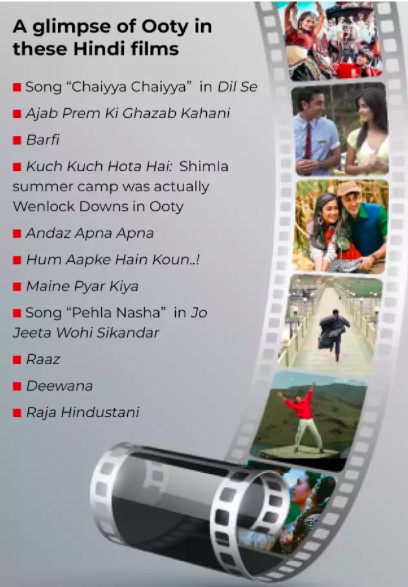Ooty. Udhagamandalam/ Ootacamund
(Created page with "{| class="wikitable" |- |colspan="0"|<div style="font-size:100%"> This is a collection of articles archived for the excellence of their content.<br/> Additional information ma...") |
Latest revision as of 08:41, 12 June 2023
This is a collection of articles archived for the excellence of their content. |
[edit] Film shoots
[edit] A brief history, till 2023
Shantha Thiagarajan, May 20, 2023: The Times of India

From: Shantha Thiagarajan, May 20, 2023: The Times of India
In the summer of 1962, writes D Thiagarajan in his book Misty Memoirs , Raj Kapoor “took utmost care to protect the enchanting lawns and flower beds of the Government Botanical Garden in Ooty” during the filming of the song "Yeh mera prem patra", sung by Mohammed Rafi in one of his greatest hits Sangam (1964).
In an interview after the film’s release, writes Thiagarajan, Kapoor said when he heard the lyrics, the Ooty garden came to mind. He was one of several filmmakers of the past who shot extensively in Ooty. The hills also make their appearance in his films Jis Desh Men Ganga Bahti Hai (1959) and Mera Naam Joker (1969). It wasn’t just Raj Kapoor. The 'Queen of the Hills' charmed filmmakers right through the 1970s too. Actors MG Ramachandran, Sivaji Ganesan and Dilip Kumar were bowled over by the Botanical Gardens, Wenlock Downs, the Ooty Lake, which set the scene for films such as Anbe Vaa (1966), Ooty Varai Uravu (1967) and Puthiya Paravai (1964).
With Kashmir out of bounds because of the unrest there, Bollywood giants made their way to Ooty, earning the town the sobriquet ‘Mecca of motion-picture making’.
Now, a weeklong festival celebrating films that ‘starred’ Ooty, is being held this month as part of the town’s 200th year celebrations. “The Ooty-200 celebration would not be complete without a festival showcasing classics such as Kadhalikka Neramillai (1964), Mullum Malarum (1978) and Pudhiya Paravai shot in Ooty,” says D Radhakrishnan, secretary of The Assembly Rooms, where the festival will take place.
Dwindling shoots
But while Ooty was the talk of the tinsel town decades ago, locals say of late, the number of shoots in the hill town has reduced drastically. Among the bigger productions, in 2021, the Akshay Kumar-starrer Ram Setu was shot in Ooty, and director Zoya Akhtar has just announced the wrap of her web series The Archies in the hill town. Still, the numbers are nowhere near their past high. Businessman and long-time Ooty resident N Yunous Sait, who knew actors such as Raj Kapoor, says, “Those days, Ooty was frequented by honeymooners as it was seen as a holiday spot for the elite. Even film stars came to Ooty for honeymooning. That’s why it held so much appeal. It was aspirational. A romance song in a movie, irrespective of its language, was not complete without a shot in Ooty,” says the 84-year-old. “That is not the case now.” After the 1980s, the number of film shoots in Ooty reduced as foreign locales began to hold more appeal and novelty, says Sait. “They became the new appeal.”
Also, with Ooty being an affordable holiday spot, it has started becoming crowded through the year. In April, Ooty recorded a 56% increase in tourist footfalls compared to the same period last year. More than 10,000 people visited the gardens every day last week. S Lawrence, a film shooting agent in Ooty, says getting permission for a shoot in remote locations in the Nilgiris such as at forest boundaries (like director Mani Ratnam managed in his 2010 hit Raavan ) and waterfalls is increasingly difficult. “On the whole Ooty has become expensive and cumbersome for shoots, which is another reason why the number of movies filmed has reduced,” he says.
“Permission for a shoot has to be obtained from multiple government agencies. For example, a film unit has to get permission through the directorate of information and public relations to shoot at the Botanical Garden. But, at the same time a ‘no objection certificate’ from the directorate of horticulture is also required,” he adds.
Environmental concerns
The reason for the stringent rules is on account of the environmental degradation to Ooty, say ecologists. What is never captured on camera is the flotsam and jetsam left behind by film units.
In 2000, the Ajay Devgan-Kajol starrer Raju Chacha created a stir with its purported threat to ecology. When former Nilgiris collector P Sivasankaran suspended the film’s schedule for violating environmental norms, he received kudos from green bodies.
V Sivadas, founder trustee of Nest, an NGO involved in environmental activities, says, “Film units are often careless about environmental issues. For instance, they use chemicals for making smoke and damage the surroundings. They also end up littering the surrounding area and never clean up.”
Ooty town accumulates around seven tonnes of dry garbage every weekday, and about 10 tonnes a day on weekends and holidays when the tourist inflow is higher. The hill town also hoards 50 tonnes of wet waste a month.
This is unlike in the past when several filmmakers were conscious of what they were doing to the grounds. When MGR, during the shoot for Anbe Vaa, noticed that the crowds that had gathered to watch him in action were destroying the lawns of the Botanical Gardens, he made a public apology.
Raj Kapoor went a step further. He cleared the debris after every shot, much to the admiration of onlookers.